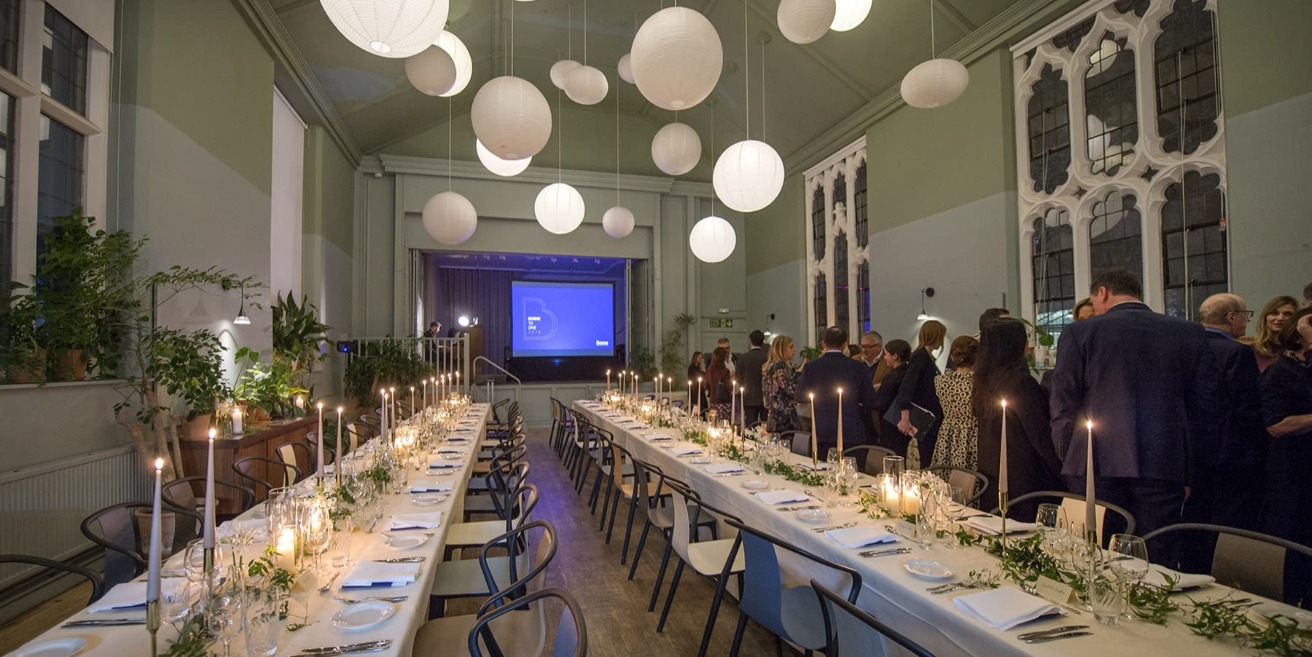Who to Invite to a Dinner Party
- Date: April 14, 2025
- Topic: Events
- Contributors: Written by Peerspace StaffEdited by Alexis Shiraki

Source: Pexels / cottonbro studio
There’s no question that choosing the right guest list is a crucial part of planning any event. But for dinner parties in particular, putting together your guest list is perhaps the central decision of the planning process.
That’s because the right combination of guests leads to engaging dinner conversation and harmonious interpersonal dynamics that make your gathering a night to remember. So, it pays to put some extra thought into your dinner party guest list.
The vibe you should aim to cultivate with your choice of guest list depends on the style of dinner party you’re planning—whether:
- Formal or casual
- At home or at an event venue
- Highly planned or spontaneous
- Thematic or potluck-style
- Or a combination of these
You may want to go for a more intimate vibe, with a short guest list containing only close friends, or you may prefer to prioritise engaging dynamics and dinner conversation (which might include inviting especially interesting people, even those you’re not very close with).
Particularly for first-time dinner party hosts, finding a balance between cultivating intimacy that facilitates meaningful connections and exciting conversation can feel a bit daunting. It may also be challenging to plan a special occasion dinner (like a holiday meal or milestone celebration) and figure out how to mix different friend groups and social circles without creating awkwardness.
Not to fear! We’ll help you navigate the process, accounting for everything from dietary restrictions to seating arrangements with grace and tact.
Table of Contents:
- Selecting Your Guests
- Thoughtful Guest List Decisions
- Planning a Great Dinner Party
- Fresh Takes on Traditional Rules
Choosing Invitees

How best to identify your potential guests? Follow a methodical process, as we’ll outline in more detail in the following sections. Start with your priority invitees, like your core friend group and other regular dinner companions. Then, expand to secondary invitees like professional connections and friends-of-friends.
If you’re considering extending your guest list even further after including these initial groups, read on and we’ll also provide specific guidance on when and why to do so.
Priority invitees
The most logical place to begin choosing your dinner party invitees is at the very top of the list: your core friend group, including close friends and regular dinner companions.
Coming in at a close second might be new friends you’re hoping to integrate into your friend group—a dinner party is an awesome opportunity to introduce them to your other friends and get a feel for how they fit into your larger group dynamics. (Keep in mind that for an especially intimate gathering, inviting a new friend who’s never met your other friends could also be a source of unexpected stress, depending on how it goes.)
Finally, dinner parties are all about great conversation (in addition to the delicious food, of course). Therefore, it’s a good idea to prioritise people you know to be particularly engaging conversationalists. You want to include a mix of guests who can keep the discussion lively while contributing different perspectives and helping create a warm, welcoming atmosphere.
Secondary invitees
Once you’ve figured out the top of your list—meaning the invitees who you’re closest with and who are truly non-negotiable—it’s time to move onto the secondary invitees. These might include your extended friend group, such as people who you’re friendly with but don’t know as well as your close friends, particularly friend-of-friend additions.
Other guests to consider including at this point in the process:
Professional connections, such as co-workers and other colleagues.
People you participate in various activities with, like sport, creative endeavours, or volunteering.
New social connections who you’re interested in becoming closer with and who you think would mesh well with your other friends (they could be priority guests, too, depending on your goals for planning the dinner party).
When to extend the guest list
By adding more faces and perspectives to the dinner conversation, expanding your dinner party’s guest list can enhance the gathering’s energy and dynamics. Simply put, inviting more guests means there will be more people for each guest in attendance to interact with.
However, making your guest list longer can detract from an intimate vibe, and it also has the potential to add more stress and increase the risk of unexpected conflict. After all: the fewer guests at your party, the fewer chances there are for something to go wrong for or between them.
Nevertheless, there may be specific instances when expanding your guest list makes sense for your goals. If you’ll be at a venue with an extra large table and/or flexible seating options, more guests can make for a more engaging atmosphere. A more flexible menu, such as one that uses buffet-style dining, makes it easier to accommodate extra people.
In addition, special occasions like birthdays or holidays often call for a larger group to make the celebration feel truly festive. Or if you host a recurring dinner series, inviting new faces can keep things exciting. Overall, consider adding more guests if your goal is livelier conversation containing fresh perspectives, or simply to make your dinner party feel more festive.
Optimal group sizes for different styles of dinner parties
| 6–8 guests: For an intimate gathering that allows for deep conversation, as this size encourages connection while still having enough people to keep discussions engaging. 10–12 guests: For a more energetic atmosphere, this number of guests is likely to create a lively mix of interactions without feeling too overwhelming. Larger groups: Although it can be challenging to hold a dinner party with dozens of guests, for example, this can work well at larger venues with buffet-style dining and multiple areas for conversation. |
Making Thoughtful Guest List Decisions

Once you’ve made your initial lists of priority invitees, secondary guests, and any other potential add-ons, your next step will be to focus on filtering and finalising those lists with the goal of cultivating optimal group chemistry.
Making these choices will also require you to account for key details like your event’s budget, the dynamics of different social groups, conversation flow, dietary restrictions, and balance between couples and single guests.
Balance your guest list with your budget
Most of us have to follow a specific budget when planning events like dinner parties. The number of guests affects not only the cost of the meal itself but also the cost of the venue, drinks, décor, furnishings like seating and tables, and other important aspects of your event.
How much will each guest cost?
The average per-person cost for dinner party meals can range from as low as £6 to as high as £45 (or even more!), depending on factors like:
- The kind of meal you’re serving
- The cost of the ingredients
- Whether it’s home-cooked or catered
Pro Tip: The more your per-meal cost relative to your overall budget, the fewer guests you can afford to invite. Ensure to keep that aspect in mind as you plan out your guest list.
Factors that affect cost per guest
If you decide to invite more guests despite the increased cost, there are specific ways to scale up your menu efficiently. You might elect to serve dishes that are easy to expand and use relatively affordable ingredients, such as casseroles or pasta, rather than serving each guest a sirloin steak dinner.
For alcohol and speciality drinks, the cost of which can quickly add up, wise beverage planning is a necessity. Serving a signature cocktail or a limited selection of affordable beers and wines can help you stay within your budget. Remember that for each guest, you may also need to pay for more table settings, including extra plates, glassware, and seating.
The style of service at your dinner party also makes a huge difference in the final per-guest cost of your dinner party. Plated dinners create a more formal vibe and typically require more resources, while buffet-style service is more affordable and practical for larger and more casual gatherings.
Navigating delicate dynamics with grace
In addition to the headache that budgeting can be, an unfortunate reality of event planning is that it can sometimes require the host to navigate delicate social dynamics. These can include accounting for interpersonal issues, like mixing different friend groups or avoiding inviting two guests who don’t get along with each other, as well as more practical issues like dietary restrictions.
Creating an enjoyable atmosphere at your dinner party will require you to realistically consider how different friend groups will interact. You’ll want to ensure there is a good balance of personalities in attendance to keep the conversation flowing naturally. For instance, if your guest list only includes a bunch of guests who are especially shy and don’t know each other well, then the conversation may be stilted and full of awkward silences.
Here’s some of our advice on achieving this occasionally tricky balance:
If you invite new friends alongside your long-time connections, ensure to introduce them and foster connections by discussing shared topics of interest.
If dietary restrictions are a concern, figure out early on whether accommodating a certain guest’s restrictions would be possible without limiting your menu too much.
Aim for a mix of guests that avoids anyone feeling like a third wheel—avoid inviting five couples and one single person, for example.
Whether you’re hosting an intimate dinner with less than a dozen people or a larger, buffet-style gathering, finding a flexible venue that can accommodate both smaller and larger dinner party groups can make planning easier. Check out the options available on Peerspace for adaptable dinner venues near you to suit any guest list.
Planning Logistics: From Guest List to Great Night

Once you’ve assembled your guest list, when should you make those key guest list decisions? How does your choice of venue affect the number of guests your event can accommodate? And—a key detail—how should you plan to arrange the seating, depending on your goals for your dinner party? We’ll answer all these questions and more in the next few sections.
Get the timeline right for your event
Now that you have a guest list established, it’s time to plan out the timeline for your dinner party—having an effective timeline for planning will help everything run smoothly from start to finish.
Begin by finalising your guest list at least six weeks in advance to give yourself plenty of time for sending out invitations.
Send out your invitations four weeks ahead, so your guests have plenty of notice and are more likely to make it.
If there are any key guests who you especially want in attendance, co-ordinate your schedule with theirs to confirm their availability.
As your RSVPs roll in, ask for and track dietary restrictions, so you can adjust the menu as needed. Once you’ve finalised all the RSVPs, plan out a specific shopping and prep timeline (unless you’re outsourcing the cooking to a catering company).
Choose the perfect space for your group
The venue you choose has an enormous impact on guest count as well as on the overall experience of your dinner party. Consider how your chosen venue’s capacity will impact your ability to include everyone on your guest list. Table size and shape are important, so make sure there is enough room for comfortable seating without crowding.
Keep in mind the limitations of your venue’s kitchen—some venues have full kitchens, others have kitchenettes, and some have none at all (these are not an ideal choice for a dinner party). If comfort and encouraging relaxed conversation are important to you, choose a venue that includes space for guests to relax.
Many venues will allow you to rearrange their tables and chairs as desired for your event. Make sure to place guests strategically to optimise conversation flow, mixing familiar faces with new ones to encourage interaction. A round dining table can also facilitate interaction. As the host, you’ll want to position yourself where it’s easiest to engage with everyone, since you’ll likely know most (if not all) of the people in attendance.
You can browse thousands of dinner party spaces that are available by the hour and, in many cases, hire them instantly through Peerspace. Especially because you can easily filter your searches by the criteria we’ve mentioned above (and much more), Peerspace makes finding the perfect space for your dinner party a breeze.
Fresh Takes on Traditional Guest List Rules

There’s no reason that a dinner party has to be a stodgy, formal event. Let go of old-fashioned etiquette rules and bring your dinner party into the 21st century with more modern strategies for assembling your guest list.
For instance:
Invite a variety of personalities to your party for more dynamic interactions.
A more casual gathering also can blur the line between the formal and informal.
You can still send out invitations, but instead of using invites hand-embossed on luxurious linen paper, simply send out digital invites to save time and money.
Or perhaps you meet for regular dinners with a particular group of close friends—if so, invite your guests to choose a theme or spontaneously include their own friends to foster new connections at your parties.
Final words

Your dinner party’s success depends on fostering meaningful connections between your guests. As the host, your goal should be to mix personalities thoughtfully, balancing the overall dynamic and cultivating a sense of group harmony.
Ready to start planning? Join the thousands of people who have found their perfect dinner party venue on Peerspace.
Get together somewhere better
Book thousands of unique spaces directly from local hosts.
Explore SpacesShare your space and start earning
Join thousands of hosts renting their space for meetings, events, and photo shoots.
List Your Space





